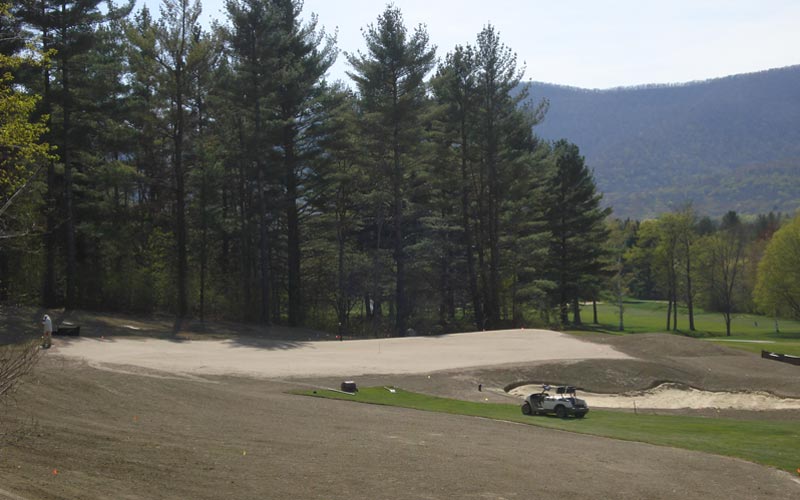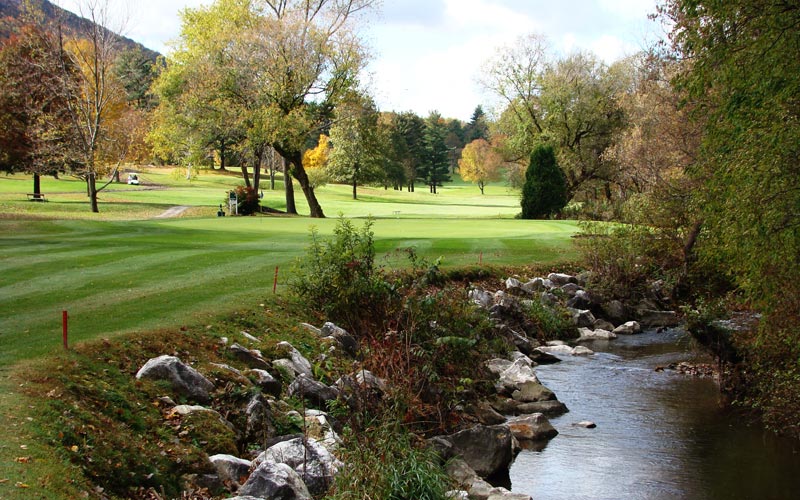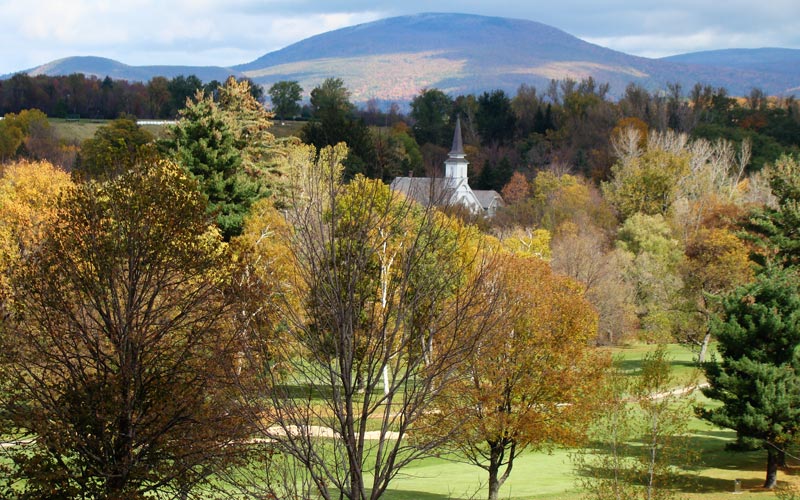Feature Interview with Jim Goff & Mark Mungeam
November, 2009
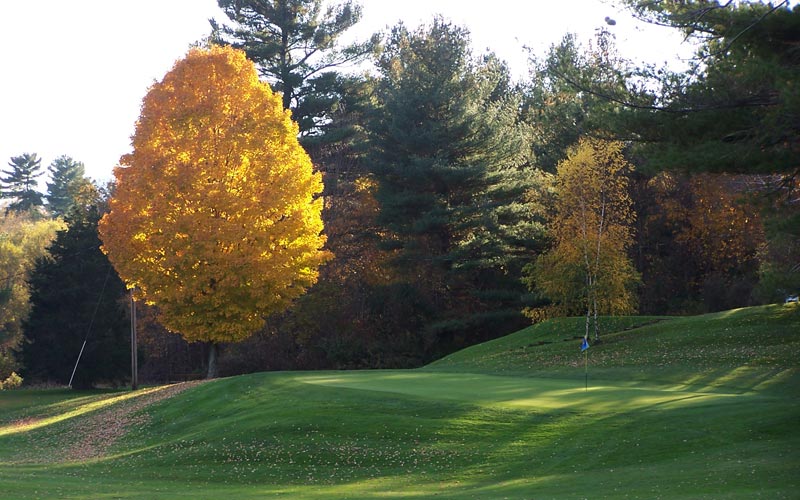
Waubeeka has always featured sharply sloping greens such as the one here at the par four sixth. Current work to the course is further increasing the pleasure of a game here by both adding strategic value to some of the holes as well by opening up long views across the New England landscape.
Interview Questions for Jim Goff:
1. What is the history of Waubeeka Golf Links? The property is quite diverse with the Green River running through the front nine and nearly a hundred feet of elevation change on the back.
Waubeeka opened in 1966. It was designed, built, owned and operated by Rowland Armacost. As you might guess, it was originally farmland. Mr. Armacost owned and operated Waubeeka for many years. He had the foresight to choose a spectacular location located along a river valley nestled in the confluence of several mountain ranges. We are the third owners of the golf course.
2. What was your connection to Waubeeka? When did you first play there?
I don’t know for sure when I first played Waubeeka. My father Rudy Goff was the golf professional at the other golf course in Williamstown, Taconic Golf Club. He was also the Williams College golf coach for 20 years. Taconic is ranked as one of the top five college courses in the country. I basically grew up there. I am guessing, but I was probably 10 years old when I first played Waubeeka. It was only three miles from my house. I subsequently played a lot of competitive golf there through my high school and college years.
A highlight for me was winning the Western Massachusetts High School Championship at Waubeeka as a senior in 1982. This was not the biggest event in the world, but as a high school kid, it was big. I had performed poorly at the event as a junior. As a senior, I was paired in the first group of the day with the defending champion. Going head to head, we tied at 74 on a wet and windy day, but had to wait four hours for the field to come in. I figured a playoff was likely. I spent a lot of time hitting balls with my father to prepare for the playoff while the defending champion sat in the clubhouse eating cheeseburgers. I won the first playoff hole handily and it was done. The picture in the newspaper showed my dad behind me as I hit off the first tee in the playoff. My dad died a few years later so that is a poignant memory for me and an emotional connection to Waubeeka.
3. What were your initial impressions regarding the strengths and weaknesses of the course?
I viewed Waubeeka as a special and beautiful place. Waubeeka is in the garden spot of the Berkshires with the river, the mountains, the varied terrain and the views. That and some interesting holes were its strengths. A weakness in my mind is the intersecting golf holes. Right off the bat, golfers on #1 would be playing down #9 and vice versa. This is not the only place on the course where this occurs. We are fixing the intersection issue in the renovation. When I was a kid, Waubeeka was generally not in very good condition. I was pleasantly surprised to find that Waubeeka had improved greatly in recent years due to the stellar efforts of Greg Tudor who was brought in 2006. Waubeeka was on the rise before we ever showed up. In particular, Waubeeka is known for excellent greens that roll well, perhaps the best in the county.
4. What were the factors that drove you to purchase the course in 2007?
The short story is that we bought it on gut instinct and without a plan.
The longer story is that my wife and I live in Denver, but we received a call from my brother Bruce (who, by the way, was a captain of the Williams golf team as well as a NCAA all-American golfer) in Williamstown who read an article in the newspaper that the course was for sale. I loved growing up in Williamstown and the Berkshires and had thought over the years about owning a piece of ground in Williamstown. I had played over 100 rounds of golf there and knew the place like the back of my hand. My parents always taught me to buy prime property. This, to me, was the premier property in Williamstown after Mount Hope Farm. My mind was racing right from the get-go and we started doing due diligence with help from my brother Bruce. My understanding was that most of the other interested potential buyers were looking to shut the golf course down and develop the property. We believe that would have been a very bad outcome for the area.
I studied the financials and looked into the management, and operations of Waubeeka. I had not been there in many years. In addition to the strength of superintendent Greg Tudor, Mark Mills, the general manager, was key to our confidence in buying Waubeeka. We live 2000 miles away and didn’t really want to commit a lot of time to worrying about the day to day operations of a golf course. Mark is an exceptional manager who runs the course effectively and efficiently. He is the heart and soul of the place as well. People like going there because of this guy – it is like “Cheers†– everyone knows your name. I also learned how intensely loyal and fanatical the members are. Having a great superintendent, a strong manager and a loyal following for the course gave us confidence that we could keep Waubeeka in operation. All of this was very reassuring. We made a discounted offer for the property. I believe that the sellers took into account our reputation as a golf family which would take care of Waubeeka.
5. What is your overall goal/vision for the course?
I would say initially that we did not have one. It all happened too fast. We took time to get to know the Waubeeka team there and what they felt were the most needed changes on the course. We hired Mark Mungeam and Tim Gerrish of Mungeam Cornish Golf Design and set about on a very limited, renovation project to address these priorities. This was simply a renovation or reconstruction of two holes. Right away, I found golf course design addictive and we hatched plans to add fairway and greenside bunkers to a few “freeway†holes to turn them into much more interesting, strategic holes.
Superintendent Greg Tudor encouraged us to develop a full course plan. I pushed back, not wanting to spend the money or commit to that scale of a renovation. Another way of looking at this is that we have been making it up as we go. It goes against the conventional wisdom of coming up with a master plan that is interconnected, but I have a family and full-time job so I basically work on this when I have the time. I believe the renovation will ultimately be better because we learned along the way, and we took our time to focus on designing one great hole at a time.
The initial renovation met strong reviews which encouraged us to keep going. I realize I have not answered your question yet. Keeping it simple, our objective now is to make Waubeeka a top ten public course in Massachusetts. We may not get there, but you have to aim high and try. We want to steadily improve the course and bring it up to its potential. Waubeeka has great bones with its topography, the river and the wonderful views. It is up to us to execute on the vision.
I love Waubeeka, but I find many of the holes to be uninspiring beyond having some good mountain views. Many are straight-away with few fairway bunkers, a flat round green, and flat left and right greenside bunkers that do not come into play. There are also a few really dramatic holes with dramatically sloped greens, like #11 and #16, that you might four-putt. But, many of the holes are fairly vanilla. I hate vanilla. The nice thing though is that this gives us a fairly blank slate to add bunkers and improved green complexes to introduce more strategy and thought into playing Waubeeka.
6. What major work has been done to the course since you purchased it?
We started by taking on the projects that would make the course more functional. The first hole was a horribly difficult starting hole that backed up the course right from the start. We worked up a renovation plan for the first hole that would make it a fair, but interesting starting hole and minimize any issue of intersecting play with the ninth.
We also felt it was imperative to build a driving range. The only logical place with enough room to build a driving range was the tenth hole. We built a first class driving range with a large tee, a private lesson tee and target greens. An additional benefit is watching the flight of your ball against the mountain range in the background.
We had to place a hole on the old, bowling alley width driving range, exchanging a par four for a par three. Before I even had the time to throw out my normal ten design ideas, Mark Mungeam produced a brilliant design that we instantly embraced. It is an uphill par three that ranges from a 150 yard front tee to a 230 yard back tee. The green is on the sky line so it is somewhat difficult to judge the distance. There is a bunker in front of the green and left, but room to approach the right half of the green with a running shot. There is a long, eight foot deep bunker on the right that runs the length of the green. Sort of Yale-esque I guess. There are grassy bowls to the left of and behind the green. Most interesting is a pronounced spine that runs from one-third of the way into the green to the back. It creates a lot of interesting chipping and putting on this green. I would rate this as now being the best hole on the course. I hope we keep using this expression as we build or renovate more holes on the course. Those were the core projects of phase 1 of our renovation.
7. You are a graduate of Yale. Does Raynor’s monumental work at Yale Golf Club impact in any way your revisions for Waubeeka?
To start, I figure that I was accepted into Yale because golf coach Dave Paterson wanted me. So, in a sense, golf led to Yale, and Yale in turn did a lot for me. I played on the golf team at Yale so I spent a great deal of time there. It was great to play there day in and day out. That course never lost its fascination.
I don’t think Waubeeka lends itself to incorporating all of Raynor and McDonald’s design concepts, but we are looking to adapt them where we can. I sent pro Ryan Callahan and superintendent Greg Tudor to play Yale this past summer so they could understand me better when I talk about potential design changes inspired by Yale. We won’t hew slavishly to a Raynor style, but that influence will definitely be there.
– I loved the horrifically deep bunkers of #2 and #8 at Yale. We will incorporate some 10 foot deep bunkers on holes #11 and #13.
– Waubeeka #13 goes steeply uphill on the second shot. We are going to rebuild the green complex to be a modified version of #10 Yale, which is one of the toughest and most exciting par fours I have ever played.
– Waubeeka’s par 3 #14 is very plain. We are excavating around it to provide vertical relief and adding deep bunkering to make it a short hole like Yale #5.
– We are completely rebuilding hole #17 from a completely uninteresting and straightforward par five to be a road hole which is far more difficult and strategic. It will never be the hole that Yale #4 is, but they both have that #17 St. Andrews road hole concept.
– I would love to build a hole similar to the Biarritz Yale #9, but that is just not possible. In college tournaments, that tee shot was always the most tense of the day.
The Yale golf team did very well when I was there. We played extremely well on the road because all golf courses seemed easy compared to Yale. But we did not do well at home – we knew how much trouble was out there and we had been beaten by it too many times. Don’t worry though, we will never be able to make Waubeeka as difficult as Yale.
8. The course isn’t heavily bunkered, featuring around twenty-five bunkers today. How many bunkers do you foresee the course having in five years? What is an example of a hole whereby bunkers enhance the strategic challenge?
There are many opportunities to create a more strategic design through additional bunkering as well as new green complexes. We don’t have the full redesign laid out yet, but I think it is safe to say that we will have added 35-40 bunkers when the renovation is complete.
During phase one, I brought up the idea of developing some fairway and greenside bunkers on the eighth and eighteenth holes which Mark Mungeam did very well. These were “blow and go†holes that required no thought on the part of the player. The par five eighth now requires a more careful tee shot. The expanded and more dramatic greenside bunkers now make the long hitter think harder before attempting to hit the green in two. Eighteen was a par four that was drivable by the longest hitters. There was no downside to going for it. There is now a large, long left fairway bunker with a narrow fairway to its right. The top players have to decide whether to attempt to fly the ball 270 yards over the bunker leaving them a short pitch to the green, lay up leaving them a 150 yard approach or thread the needle down the right side. The green itself was already strong. We added a pot bunker to the left of the green and slopes that funnel toward it. Short and right we added an enormous bunker. If you hit into the first part of it, you will be left with a very long bunker shot to the green. I was just reading in the “Secrets of the Great Golf Course Architects†that Gary Player does not accept the long bunker shot as something a golfer should be subjected to. Oops! I take the blame for that one. I keep a file of my favorite quotes on golf course design. One of my favorites is: “He simply designed and built one arresting hole after another.†(Quote on Gil Hanse design of Inniscrone from GolfClubAtlas.Com) We won’t do a lot of these long bunker shots, but I believe each hole you build should potentially provoke discussion after the round as to how it made you feel, or think, or some element that was interesting or unique. Eighteen will do that now.
9. What would you like to see happen over the next few years?
We just started on phase two this fall. We are essentially rebuilding all of the remaining holes that are not within the boundaries of wetland or riverfront protection areas. Phase three, which is much of the front nine that runs along the Green River, will require us to fully design and permit this work. We have lots of ideas for the front nine, but right now we are focused on getting the details of phase two right. Phase three will probably move forward in a year or two.
Phase two includes a lot of the Yale or Raynor-influenced work I already talked about including #11, #13, #14 and #17. #13 and #17 have the potential to become the “new best hole on the course†if we get them right. Additionally, we decided to build a new par three #16. The current green which is a source of a lot of excitement, or should I say three and four putts, is too close to the driving range. Unfortunately, we were running out of room. This time, Tim Gerrish of Mungeam Cornish Design stepped up proposing to cut down the woods on the left to create room for a new tee and approach to a completely new golf hole – a reverse redan with a beautiful look. Like #10, MCD drove this hole 100%. This hole, as well, could become another contender for the “new best hole on the course.â€
10. What is your favorite and least favorite hole on the course and why? How would you like to alter your least favorite?
My favorite hole prior to the redesign was #11. It is a long, sidehill, uphill par four to a green that sheds balls. It is another one of those greens that creates a lot of “excitement.†I love the fact that it is a great hole with no bunkers. By all rights, we should leave it alone. But, because the hill the green is on falls off sharply to the right, it creates one of the only natural opportunities for a deep Yale-type bunker. I had to seize the opportunity – we will be building this during phase two.
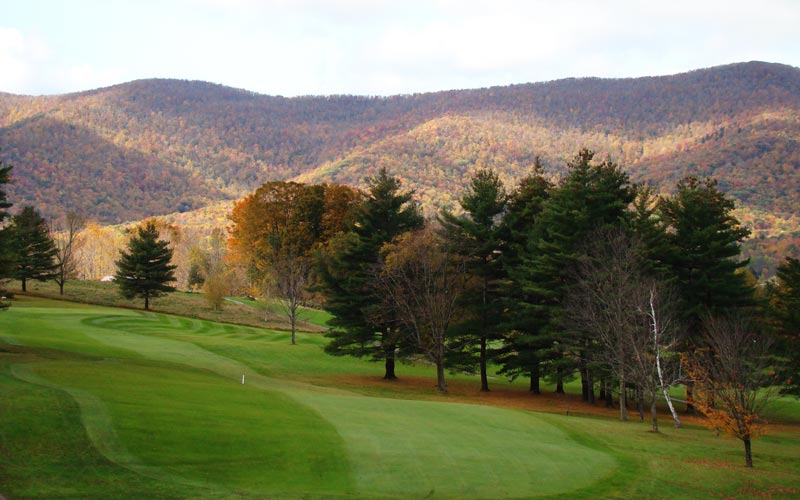
Apart from being the best hole on the course, the sidehill eleventh also affords one of the best long views from the course of the surrounding mountains.
My least favorite holes are the remaining “vanilla†holes including #2, #3, #4 and #5. I view it that we have nothing but upside here. Unlike the back nine, the front nine along the river is relatively flat. We will need to add some mounding and strong, elevated green complexes to make the front nine more interesting.
11. What can be done to bring the Green River more into play, both visually and strategically?
The quick answer is not that much given the strength of the riverfront protection laws in Massachusetts. We will explore this further as we work on the phase three design. The mile of the Green River running through the course will most likely continue to be an underutilized asset of Waubeeka. I guess we can go fly fishing though!
12. You bought the course in 2007 and the economy suffered a major body-blow in 2008/2009. As an owner, what are the ways in which you hope to recoup your significant investment in Waubeeka Golf Links i.e. will a superior product lead to greater revenue?
I believe we are already seeing this. The renovation is generating a lot of buzz. We are, at the very least, doing a lot better during these tough times than a lot of the other courses we speak to in the Berkshires. This course has not seen much investment since it was built in 1966. It still hung in there because of its beauty and charm and the devotion of its membership. Add spectacular golf to the already spectacular grandeur of the location and you have a winning combination.
I am in the investment business where we focus a great deal on return on investment. Our investment into Waubeeka is and will continue to lead to better results, but this is not really about return on investment. This is more about investing in a special place that we love and reinvesting in Williamstown and the game of golf which has done a lot for me and my family.
13. What process led you to hire Mark Mungeam? How do the two of you interact?
Given that we are 2,000 miles away, this was one of many situations where the team at Waubeeka does the heavy lifting. Superintendent Greg Tudor researched potential architects speaking to a number of his peers in the industry who had gone through renovations to ask for recommendations. Four names came to the top. After interviewing all four, and touring the golf course with each group, it was obvious to Greg that Mark Mungeam was the best candidate.
I interviewed Mark as well. We had a lot in common in our views on how to improve Waubeeka. He welcomed my interest in introducing some Yale or Raynor/McDonald inspired concepts to Waubeeka. Mark is hands on, and willing to listen to our questions and concerns. His personality and professionalism are a perfect match for us. He has been a true asset to us during this renovation.
The creative process has been interesting. The great thing for me about it is that we have no committee or politics. Mungeam, Gerrish, Callahan, Mills, Tudor and I have a regular dialogue about design ideas for the course. We have gone back and forth on emails, sending sketches or photos of ideas to incorporate into particular holes. This is where GolfClubAtlas.com has been very helpful. Occasionally, we have conference calls on design ideas. Sometimes the ideas come entirely from Mungeam and Gerrish, sometimes from the Waubeeka team and sometimes from me. I have a quote on my wall at work that is something along the lines of: “It is amazing what can be accomplished when it does not matter who gets the credit.†(John Wooden) I feel it is important to surface a lot of ideas, generate a lot of discussion and debate and let the best ideas come to the top. It does not matter where it came from. We are able to move quickly on good ideas.
It is all good for me because I get to play benevolent dictator. The rest of the guys, however, have to put up with me. I generate lots of ideas and maybe one out of ten is good. They frequently have to politely, or sometimes sternly, let me know which ones are bad. Overall though, it is a strong and exhilarating creative process.
There was some tension in the process particularly early on. The belief was that I was leading us to make the course too difficult for a public course. I am known as “Dr. Evil†because 99% of my ideas involve making the course harder. Setting an objective of making Waubeeka a top ten public course in Massachusetts sort of emboldened the rest of the Waubeeka team to be more on board with this direction. Additionally, the strongly positive reaction to the early changes to the course gave us confidence that we were going in the right direction. I chide them in fun sometimes now because they are now coming up with ideas that go beyond even me in degree of difficulty. Golfers want a challenging and interesting course that inspires them and makes them think. The course should always leave them wanting to have another go at it.
I have been reading golf course design books and spent a lot of time as well learning about golf course design on GolfClubAtlas.Com. This is one of the most fun things I have ever done. I have heard authors in several books say that the outcome of a design or redesign can only be bad if you let the owner be involved. For better or worse, Mark Mungeam has been great in terms of letting me be involved in the design process. I know I am a novice, but I am fascinated by course design and I am enjoying it greatly. If this project works extremely well, the credit goes to Mungeam Cornish Design. If not, blame it on the owner!
Interview Questions for Mark Mungeam:
1. What impresses you the most about the original architect’s work?
What I admire the most is the architect’s use of some varied and extreme topography to form a very solid routing. The course follows the minimalistic style of design before such a term was in vogue. When this course was built, it was necessary to fit the course to the land so as not to spend a lot of money on construction and enable the facility to actually be profitable. Armacost created a great circulation of holes with little earthmoving, no long walks and few blind shots. I feel the course has endured with a loyal following because the routing makes it so inviting to play.
The routing changes direction after each hole with no two holes being parallel. Good use is made of the high points on the site for tees and any little knolls and ridges became natural green sites. Although short in length by modern standards, the course has a good mixture of hole lengths that makes it interesting to play. I would much rather see a 6300 yard public course with par 4’s that vary between 300 and 450 yards with a lot of holes in the 350-400 range, than one too long with too many par 4’s over 400 yards.
You forgot the 8th green on your list of steep putting surfaces!! Yes, there are several greens on the course that are borderline unfair. Those greens would be impossible if the height of cut were lower. Fortunately, Greg Tudor, the superintendent is aware of the issue and does not cut the greens too short. This keeps them healthy while allowing him to tweak the height or roll and double cut if he wants to achieve more pace for a special event. As you know, there is a balance to be struck between steepness and maintenance. Putting surfaces can have some undulation and slope as long as they are not shaved too close. Overall, the greens roll well and are a strength of the course.
2. Walk us through the process of re-bunkering the par-5 eighth hole.
The 8th is a picturesque hole that plays from a distinctly elevated tee to a level fairway. A small brook crosses the hole between landing zones, from which the terrain rises gently to the steeply sloped green set comfortably on a nice ridge. The slight dogleg left hole originally had no fairway bunkers, but the inside of the landing zone was guarded by three small pine trees. The unattractive trees blocked visibility of the green from the tee box. It was an easy choice to replace them with a series of bunkers on this “line of charmâ€. We discussed the configuration and shaping of the bunkers with Jim, who felt that the far bunker should pinch into the fairway and the outside of the bunker be deeper than along the fairway to penalize more wayward shots. The first bunker in the series is in the drive zone of the average player. There is a gap, than the next two should only affect the long hitter with the ability to reach the green with two bold shots. With the greens sharp right to left slope, these hazards really guard the best angle of approach.
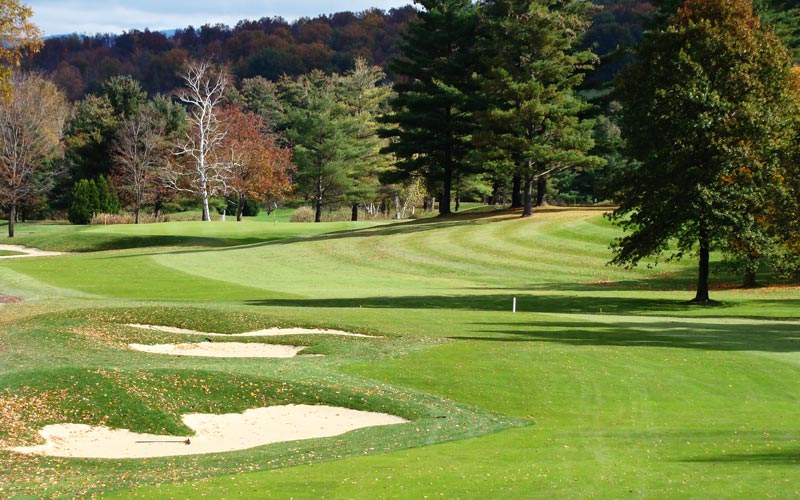
These newly created fairway bunkers guard the best angle into the steeply canted right to left eighth green.
At the green, the left front bunker was rebuilt in a Raynor style and a new rear bunker added. I was apprehensive about the bunkering concept here due to the severity and dome shape of the putting surface. Raynor greens are more cupped or level at the edges, whereas this Armacost green has distinct roll-offs. On the front bunker, we opted to raise the collar to improve the transition between putting surface and bunker edge. We left the collar to pitch toward the back bunker, resulting in many shots rolling through the green and down the steep slope into the hazard. Jim loves this!!

The new greenside bunker at the eighth is both deeper and larger than any bunker that existed before Goff purchased the course.
3. Tell us about the origins of the work done to (and around) the tenth hole including the spine.
We prepared several concept plans for the 10th hole, than discussed them with the Waubeeka team. The hole that resulted is a collaboration of different ideas from all involved. The plan basically evolved. The shape and angle for the green were stolen from one at Fishers Island. The deep right bunker wraps around the side and behind in distinctly Raynor fashion. A ball aimed at the right front of the putting surface and hit too far will carry across the green and down into this hazard. The spine was Tim Gerrish’s idea as a way to include a classic feature to the putting surface. With the uphill tee shot, I wanted the back of the green to be the horizon line for players view. Mounding to the left and rear was introduced to mimic the adjacent mountains and provide a buffer from the 16th hole (this was before we decided to move that green).
4. Tell us about the tree and brush clearing program.
Waubeeka occupies a beautiful and inspiring setting in the valley between several mountain ranges. People flock to this area in the autumn for brilliant foliage. Each time I visit I see a new view I hadn’t previously noticed – whether a church steeple, a distant barn or a high meadow with cows grazing. In the years since opening, some of the woods had grown thick with saplings and numerous trees were planted to provide greater separation between the holes. These trees had eliminated some of the long and short views. Consequently, Greg Tudor has overseen some extensive tree removal that has opened up the site to many new vistas. In my opinion, there aren’t many courses with such pretty views, so Waubeeka should definitely flaunt this unique advantage.
5. The seventeenth hole is presently closed and undergoing some significant re-work. Tell us what is happening?
I think #17 is one of the weaker holes on the course and we are trying to make it more interesting and improve the visual character. It is a short par-5 with a blind drive and blind second shot, so that is not a great start. Jim had some definite ideas on strategic elements that he wanted to see incorporated into the re-design of the hole. I thought his ideas were mostly good ones and have worked to include them with our own.
As noted, the tee shot is completely blind. Players aim at a point on the foothills of Mt. Greylock (the highest point in Massachusetts), which is directly behind the green. Though the fairway is not visible, the mountains make a spectacular backdrop. We discussed lowering the ridge in front of the tees to make the landing zone visible, but our evaluation determined that it would take a huge excavation to accomplish this goal and was not worth the effort.
The landing zone slopes sharply from left to right with out of bounds down the entire right side of the hole. Many good shots roll across the fairway into the right rough. Jim suggested we use the OB as a strategic element by raising the right side of the hole a little and expanding the fairway closer to the property edge. The green would also be shifted right a little and designed to favor a shot from the right side of the hole, thereby giving the player who risks driving it down the right side and closer to the out of bounds line a distinctly better angle into the green. We also added a fairway bunker to the left side of the hole. We differed in opinion on this feature. With the blind drive, I was against having a bunker that would catch the average player who thought they had hit a good drive. We decided to include the bunker, but its position is beyond all but the longest hitters.
The green formerly was visible from only about 120 yards in. This we felt could be greatly improved, so we lowered the fairway elevation 3 to 6 feet between 150 and 80 yards from the green to open up the view from much farther back. Now one can get glimpses of the putting surface even from the start of the fairway.
Since we started working on the project, Jim had expressed hope of building a boomerang shaped green. We thought #17 was a great location for this feature. As a short par-5, we felt the green complex and putting surface should provide some defense to an otherwise easy hole. The new green will require nerve and precision on approach shots. Players will need to hit to the correct area of the green, and mis-hit approaches will get repelled by the false front and collected by the central pot bunker which the putting surface curves around. The challenge should be a lot of fun.
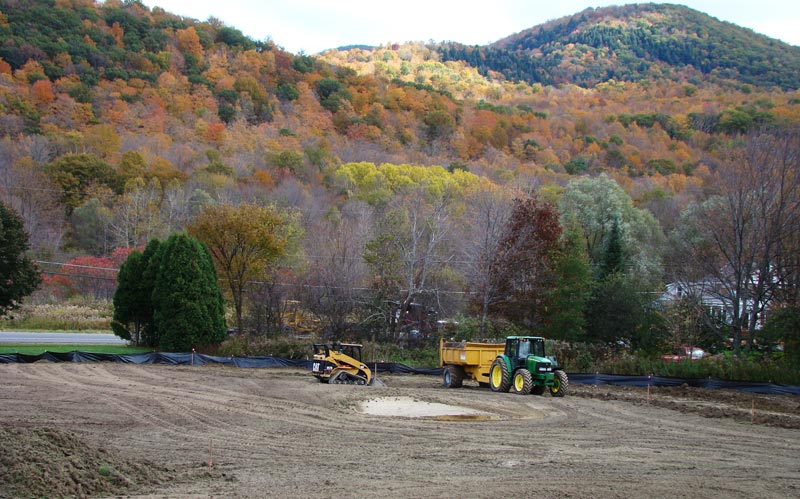
A boomerang green starts to take shape during the fall of 2009 when the seventeenth was closed for play.
6. What other classical design elements do you hope to see introduced?
I don’t have a certain design element that I want to incorporate. For the new 16th green, we had originally intended to build a “reverse redan†green. During construction, I was not happy with the visibility of the putting surface. I prefer being able to see the ball slingshot off the bank and roll across the green. That’s what makes the concept fun to play. The uphill nature of #16 did not permit visibility on the rear sloping green, so instead we redesigned the green complex as a combination redan and double plateau. By raising the back third of the green and keeping the redan edge at the front left, we created a green that is more visible yet still classic in character. We won’t finish the shaping until spring, but I really like the way it is coming out.
As we get to the front side, I know there will be more opportunities to incorporate some classic design elements, but I do not have any preconceived ideas on what those elements will be. I really need to study those holes some more.
7. How is it working with an Owner who has so many ideas about golf course architecture?
It is usually a lot of fun. Jim has really been studying his golf design books and following the threads on golf club atlas. He is really interested in design and his enthusiasm for incorporating elements he has seen or played is really infectious. It is a new method of designing for me. I am much more used to a more singular and insulated method of design. In the planning stages, Jim and I often discuss the layout of a hole or green, but once the hole is under construction, the decisions are generally mine to make.
With Jim, Greg Tudor, Ryan Callahan and Mark Mills of the Waubeeka team involved, the process has been a little different. We produce multiple concepts, discuss their merits, revise the concepts, revise them again, etc. There have been times when we have been forceful on an idea we feel strongly about. There has also been occasions where Jim has said he wants it a certain way and we know enough to design it that way.
As Jim noted, the most difficult hurdle for me was the fear we were making the course too difficult to play and maintain. I was concerned that too many deep bunkers would result in public golfers going elsewhere. Although I was in favor of some dynamic new features to better define the course, I was wary of the modifications making the course much more difficult to play and maintain, thus impacting rounds and cost of maintenance. The Waubeeka team, Jim and I discussed these concerns and we decided that the modifications would make the course better, that it would be more dramatic and invigorating to play, and that this excitement would attract a whole new group of players to support the renovation. Jim challenged me to explore alternate routes and design features that would keep the course fun for all levels of play. This has always been our goal.
The End


